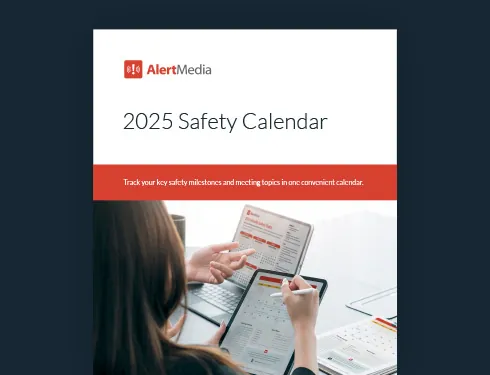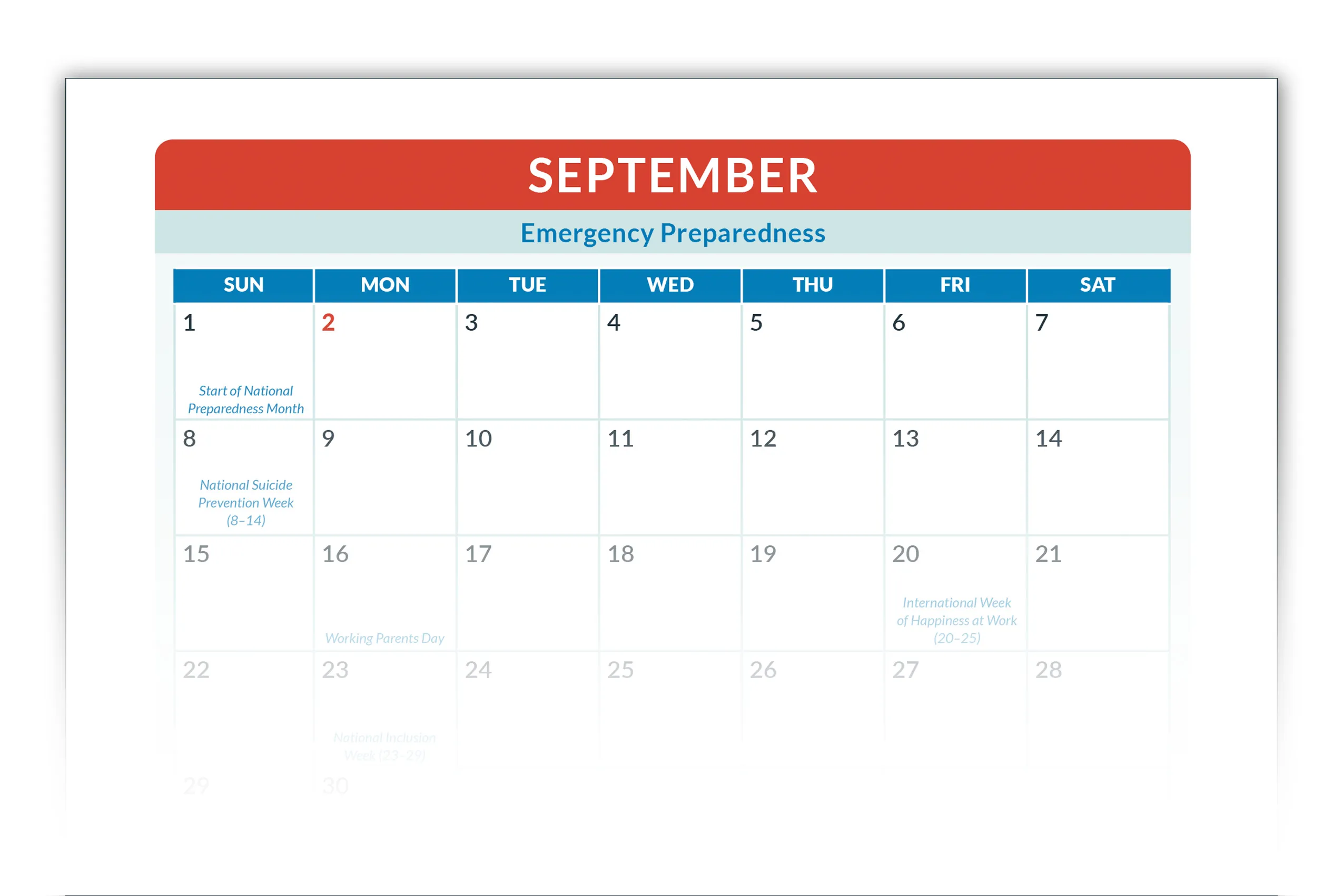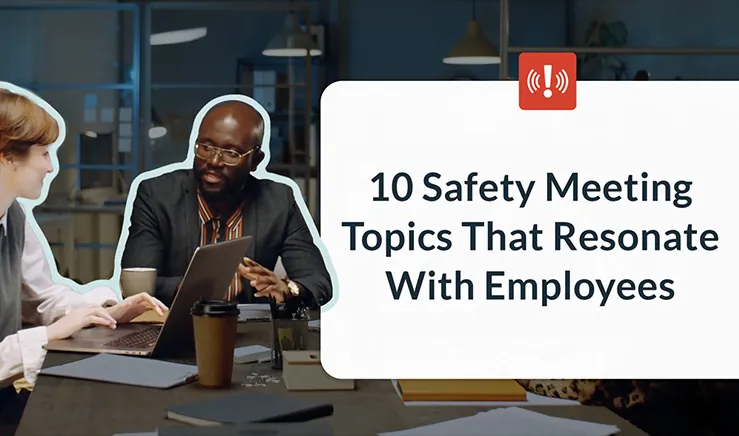
2025 Safety Calendar: How to Organize Your Preparedness Efforts
Safety isn’t just a responsibility—it’s also a way of running an organization. Keep your people safe and expand your preparedness efforts by planning for the year with a safety calendar.

There’s no universal list of occupational safety hazards or complete guide to address them all. And if there were such a list—the severity of threats ebbs and flows over time, meaning that list wouldn’t stay useful for long. Instead, you can take an all-hazards approach to prepare for all potential disruptions your business might face—based on your industry, location, climate, etc.—and this plan provides generalized guidance that can work even when an emergency plays out very differently than expected. This approach results in a plan that prepares for virtually all hazards.
It sounds promising, but how do you go from concept to actual? How do you decide when to enact the various recommendations in your plan? When do you hold safety training sessions and perform reviews in the most effective way? When does it make the most sense to talk about your inclement weather policy, fire safety protocols, or mental health in the workplace?
The answer is simple: Use a safety calendar!
Download Our 2025 Safety Calendar

Why Use a Dedicated Calendar for Safety Planning?
A safety calendar is precisely what it sounds like: a calendar that plots out your company’s safety plans for the year in the standard 12-month arrangement.
Not only do these calendars help everyone remember when training programs, initiatives, and other activities occur, but they can also organize safety events around themes. By aligning monthly areas of focus, observance calendar dates, prevention months, and preparedness objectives, these calendars can keep everyone on the same page and avoid overloading them with too many subjects at once.
For example, for workers already overwhelmed with safety equipment training, being asked to learn heat safety protocols to prevent heatstroke and practice evacuation procedures simultaneously will likely result in them missing critical information. If those workers are instead presented with activities and initiatives that are all part of the same theme, they’re more likely to retain crucial info.
Creating a safe organization isn’t the responsibility of safety leaders alone—it’s part of the company’s overall safety culture, which requires everyone to engage with the initiatives and exercises.
Breakdown of a Safety Calendar
Our safety calendar includes all 12 months of the year and comes pre-filled with major safety observances, such as World Health Day and Distracted Driving Awareness Month, to help spark safety topic ideas and engagement.
Robust safety calendars, such as AlertMedia’s, approach the challenge of a safe workplace from three angles:
- Preparation & planning
- Implementation & training
- Safety talk topics
—Penny Neferis, Director of Business Continuity, JetBlue
Preparation & planning
This is where your theoretical, behind-the-desk work takes place. Before you start organizing emergency drills, training sessions, or tabletop exercises, you need to align with plans and policies.
Your calendar will note which topic is the focus for each month. For example, January’s suggested topic is inclement weather, so you’d probably concentrate on preparing for the impact of icy roads; slips, trips, and falls; shelter-in-place procedures; and other weather-related hazards.
With your monthly themes in mind (which may deviate from our suggestions), you can begin drawing up your preparation objectives. For inclement winter weather, your goals might be to
- Create a natural disaster policy
- Improve communication protocols
- Review and improve parking lot safety rules
You could include many more or very few objectives, depending on the needs of your organization, your available resources, and your existing preparedness activities. Over the course of the year, plan to account for every potential disruption or threat that you could reasonably expect and prepare for. An All-Hazards Preparedness Guide might come in handy at this stage.
Implementation & training
Now the fun begins! As long as your idea of fun is safety activities—and we’d like to think it is.
Implementation and training are where the rubber meets the road. Here, leaders and/or employees unite to test, practice, and jumpstart actionable plans. These exercises can be on an individual basis, such as an online training module, or they can be group-based, like evacuation drills or equipment training.
For our example of a company prioritizing inclement weather preparedness in January, their implementation and training regimen might include the following:
- Running a shelter-in-place drill
- Testing the mass notification system to confirm correct contact information and message delivery
- Delivering a training session on driver safety and highway safety in icy conditions
When compiling your list of actions for the month, keep in mind your organization’s current state of safety implementation and training. Ask questions like: What topics have you trained on previously? Are new hires trained on these threats and procedures, or only veteran employees? What emergency scenarios are most likely? Which of these activities will be most effective in preventing serious harm like injuries or fatalities?
Preview of our 2025 Safety Calendar, a fillable template
Safety talk topics
There’s no substitute for careful planning and full-scale training for emergency response plans, but sometimes you don’t need a big production to get one safety idea across to your employees. That’s where regular safety talks come in.
Say you have one important workplace safety tip, like methods for protecting employees during a hailstorm. By holding a short 5–10-minute meeting at the beginning of a workday, you can convey this important information without overloading everyone with training.
You can use these short safety talks to reinforce your big plans, too. Say you held that meeting about driving safely in inclement weather four weeks ago but want to refresh everyone ahead of a big storm that’s forecast to hit town. A brief safety moment can remind everyone of the earlier presentation’s key points and ensure the information is fresh.
Run these safety meetings on a regular basis but not too often. Many organizations find that weekly or biweekly safety meetings are regular enough to cover a wide variety of topics without spending too much employee time or overloading people with information. A safety meeting agenda can help you organize the most critical information to support your broader preparedness efforts.
Examples of short safety talk topics for January include:
- Proper ergonomics for remote working
- Slip, trip, and fall prevention
- A refresher on the signs of frostbite
We have a whole post dedicated to December and January safety topics. Check it out for more safety meeting ideas for the winter months!
When and How to Use Your Safety Calendar
You can start planning at any point in the year. Look ahead from where you are now to set realistic milestones, and schedule timely training and meetings to support preparedness efforts.
Safety trends and changes in your environment might require updates and revisions to your calendar. This document isn’t set in stone; keep it up-to-date. Schedule regular reviews and revisions of the calendar. This could be quarterly, annually, or however often works for your business, but as a rule of thumb, update your safety calendar at least every year.
We’ve included three sections on each monthly page where you can list the various elements you plan to cover: prep & planning, implementation & training, and safety meeting topics. Once you fill out those sections, you can plot them on the calendar in a way that makes sense for your team and your high-level preparedness goals.
Finally, share the document with team leaders or even all employees! Since safety is a collaborative effort, everyone should be aware of upcoming initiatives.
AlertMedia’s 2025 Safety Calendar Highlights
If you’re looking for unique events and topics to put on your calendar, you’re in luck! Subscribe to AlertMedia’s The Employee Safety Podcast to hear the insightful episodes lined up for this year.
Keep an eye on social media, such as our Linkedin, to learn about new episodes as soon as they launch!
Our calendar template also includes days and months of safety observance, including many listed on Ready.gov’s preparedness calendar. Here is a quick look at all safety-related events listed in our downloadable calendar template:
JANUARY
FEBRUARY
MARCH
APRIL
MAY
| JUNE
JULY
AUGUST
SEPTEMBER
OCTOBER
NOVEMBER
DECEMBER
|
Your Company, Your Calendar
AlertMedia’s 2025 safety calendar offers the best way to get a bird’s-eye view of your organization’s upcoming safety plans. While we included some baked-in events like safety holidays and sample ideas to get you started, most of the document is blank. That’s because only a custom safety calendar that takes your business risks and priorities into account is worthwhile. Relying on something off the rack won’t enable you to consider all of the variables that make your company unique, and it might even waste your time by focusing your attention on something inapplicable to your business.
Ultimately, only you and your employees know how to meet your safety challenges, but a safety calendar is a big help when pulling it all together.






